
* Aircraft design was advancing very rapidly in the 1950s, and a new combat aircraft could be designed and built in a relatively short time at modest expense. The result was that a large number of machines were introduced in that decade, with each quickly obsoleted by improved successors. One of the unusual combat aircraft introduced during the 1950s was the "Douglas F4D-1 Skyray", a modified-delta single-seat carrier-based air combat fighter, derived from German design concepts developed late in the Second World War.
The Skyray was an innovative aircraft, but it was only built in limited numbers and had a short service life. It remains interesting, though almost as much because of its faults as its virtues. This document provides a history and description of the Skyray -- as well as the experimental "Convair XF2Y Sea Dart", the only other US Navy delta fighter.
* After the surrender of Germany in May 1945, two Douglas company aerodynamicists, Gene Root and A.M.O. "Amo" Smith, went to Paris to assess aerodynamic data captured from the Germans. The two obtained quite a haul of material, including wind-tunnel test data performed on models of tailless aircraft designed by Dr. Alexander Lippisch. Lippisch had actually developed a production tailless combat aircraft, the Messerschmitt Me 163 rocket fighter, and had many other ideas for tailless aircraft, particularly with delta wings. Root and Smith also had an opportunity to chat with Dr. Lippisch, who was then in Allied custody in Paris.
The Douglas company found the tailless delta configuration very interesting. Early jet engines had poor fuel economy and limited range, and the delta not only promised aerodynamic efficiency to make the most out of the available engine power, it also provided plenty of volume to accommodate internal fuel tanks. Wind tunnel tests on models initiated in 1946 gave excellent results, encouraging Douglas engineers to think they were on the right track.
Although the tailless delta was seen as potentially useful for a number of aircraft configurations -- including bombers, fighters, and transports -- studies focused in particular on a delta-winged interceptor. In January 1947, the US Navy issued a request for a short-range carrier-based interceptor. Douglas took the tailless delta interceptor concepts off the back burner and assigned the design the company designation of "D-571". The project was under the overall direction of Douglas chief engineer Ed Heinemann at the company's plant in El Segundo, California.
The initial D-571 configuration, drawn up by R.G. Smith, was a straight delta flying wing, with a tailfin but no distinct fuselage, very much along the lines of some of the advanced unbuilt wartime German jet fighter designs. The design gradually evolved to the "D-571-4", featuring a smaller rounded-off delta wing -- with a shape somewhat reminiscent of a valentine heart -- and a distinct forward fuselage.
The Navy liked the Douglas proposal, and awarded the company a contract for two prototypes on 16 December 1949. The prototypes were assigned the service designation of "XF4D-1." The aircraft's resemblance to a rayfish led Douglas to give it the name of "Skyray". Construction of the prototypes was performed in secrecy, and all information released to the public on the project was heavily screened.
The first prototype made its initial flight on 21 January 1951 from Muroc (later Edwards) Air Force Base, with test pilot Larry Peyton at the controls. The flight was exciting, in a bad sort of way: Peyton found the aircraft inclined to pitch up dangerously, partly because of the way its flight controls had been configured, and found handling the machine generally troublesome. He did manage to get it off the runway, after an up-and-down bob that made those watching think the machine was going to pitch over and crash, and got it back down again after running it through its paces.
Peyton, who was more accustomed to test-flying large aircraft like heavy transports, did not want to, and never did, fly the Skyray again. Test pilot Russ Thaw took his place. The problems that had afflicted the initial flight were quickly corrected, with Thaw performing taxi tests to validate the fixes; the second flight of the aircraft was nowhere near as menacing as the first.
Thaw was later joined by Bob Rahn. Rahn had watched Thaw's test flights and had misgivings about flying the aircraft. Once he got into it, he found the stick forces were very heavy and handling at high speeds was rough. His initial efforts at spin tests were downright terrifying: the Skyray could (usually) recover from a spin, but the book had to be rewritten to tell pilots how to do it. Despite all that, Rahn called the machine a "fighter pilot's dream", the best machine he had taken into the sky since flying the Spitfire. Its instability made it supremely agile for a skilled pilot, and Rahn claimed that he out-flew every Air Force chase plane sent up with him. Marine Major Marion Carl, one of the top test pilots of the era, flew the Skyray and claimed: "If we had this airplane now in Korea, I could just pop off the MiGs -- one, two, three."
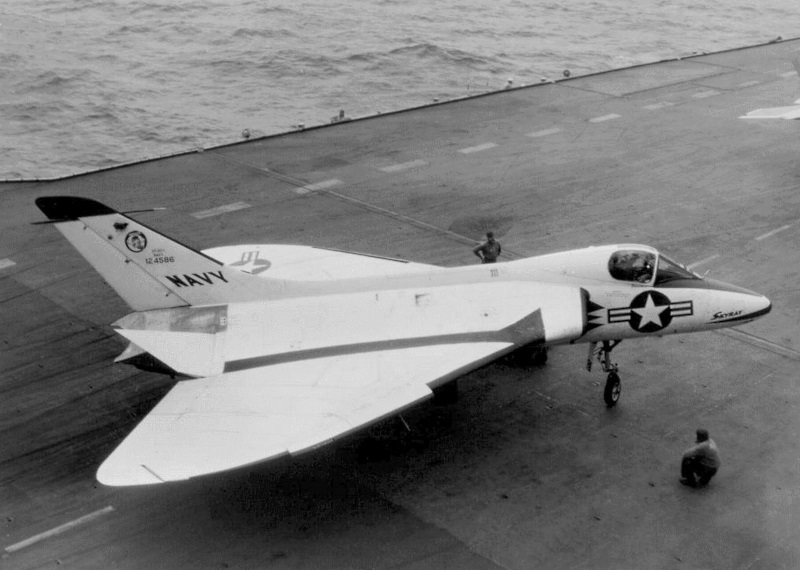
Although the prototypes initially featured a blunt nose, they were quickly fitted with a nose pitot tube for test purposes. Both machines were initially painted midnight blue, but they proved hard to spot and so were repainted in an overall white scheme. Non-availability of the Westinghouse J40 engine meant that both were initially fitted with an Allison J35-A-17 turbojet with 22.3 kN (2,270 kgp / 5,000 lbf) thrust, leaving them badly underpowered. The prototypes were later refitted with the Westinghouse XJ40-WE-6 non-afterburning turbojet engine with 31.1 kN (3,175 kgp / 7,000 lbf) thrust. It wasn't that much of an improvement, particularly since Muroc was at relatively high altitude, and the engines performed substantially under their ratings; the Skyray prototypes were generally outpaced by F-86E chase planes.
The prototypes were then refitted with the XJ40-WE-8 afterburning turbojet with 51.6 kN (5,260 kgp / 11,600 lbf) afterburning thrust. Powered by the XJ40-WE-8, the Skyray achieved a world speed record of 1,213 KPH (753.4 MPH) over a 3-kilometer (1.86-mile) straight course on 3 October 1953, with US Navy Lieutenant Commander James B. Verdin at the controls. On 15 October, Bob Rahn took the Skyray on a 100-kilometer (62.1 mile) closed course, setting a new speed record of 1,172.3 KPH (728.11 MPH). Attempts to set an altitude record failed due to the erratic operation of the XJ40 engine, a sign of things to come.
Rahn's 100-kilometer record stood for five years, but that was mainly because nobody wanted to try it again for a time: the Federation Avionique Internationale's rules specified that the 100-kilometer run be conducted at low altitude, which became increasingly unsafe as the speed of aircraft increased. Although the Skyray was leading-edge in 1953, aircraft design was evolving so quickly that within a few years it would be outclassed in terms of raw performance.
The J40 engine's development continued to be troubled, and in fact it would more or less drive Westinghouse out of the jet engine business. In March 1953 the decision was made to put the Skyray into production using the Pratt & Whitney J57-P-2 afterburning turbojet engine with 64.5 kN (6,580 kgp / 14,500 lbf) afterburning thrust. The change was not very troublesome: Heinemann, realizing that designing a fighter around an engine that was still in development was risky, had made sure from the outset that the Skyray could also accommodate the J57 if push came to shove.
As far as the prototypes went, the first ended up as a firefighter's training rig and was ultimately trashed. The second, after a career as an engine testbed (discussed later) was, at last notice, on display at the Navy installation at China Lake, California.
BACK_TO_TOP* The first production F4D-1 Skyray made its initial flight on 5 June 1954. Along with the J57 engine, the production aircraft featured numerous small changes and was fitted with the Aero-13 fire-control system, featuring Westinghouse AN/APQ-50 radar. Due to delays in delivery of the radar system, initial production Skyrays weren't originally fitted with the radar, and apparently a handful were never refitted with it. The radar was impressive for its time, with a normal detection range of 29 kilometers (18 miles), and a lock-on range of 20 kilometers (12 miles). It was a major step forward in featuring an integrated design, with the entire unit sliding out for service; earlier radars had consisted of a set of boxes hooked together with wiring.
Operational deliveries to the US Navy and Marine Corps did not actually begin until April 1956. That was an unusually long development cycle for those days, with the delays attributable to the problems with engine development. In fact, 38 Skyray airframes were completed without engines and parked so that they could be fitted with either the J40 or J57 engine when the issue was resolved.
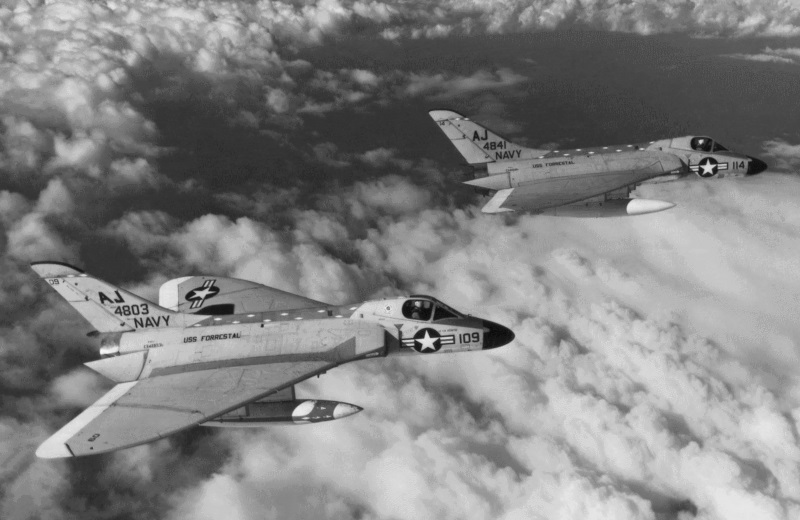
The F4D-1 was arguably an attractive aircraft; it was unarguably distinctive, different in appearance from any other jet fighter ever put into operational service. It was of modified tailless delta configuration, with rounded-off wings and a tailfin, but no tailplane. The wing folded up outboard and featured inboard and outboard leading-edge slats, plus inboard and outboard elevons. There was a hydraulically-actuated airbrake on the rear of the wingroot, top and bottom on both sides, for a total of four airbrakes. There was also a guillotine-blade-shaped "pitch trimmer" control surface on each side of the engine exhaust. The tailfin was fitted with a two-section rudder.
Although early production Skyrays were fitted with the J57-P-2 engine, later production featured the uprated J57-P-8B engine with 45.4 kN (4,625 kgp / 10,200 lbf) dry thrust and 71.8 kN (7,255 kgp / 16,000 lbf) afterburning thrust. The engine inlets were of fixed triangular configuration, with a set of rods inside to ensure uniform airflow across the front of the J57 engine. There were "splitter plates" next to the fuselage in front of the inlets to ensure that stagnant "boundary layer" air wasn't sucked into the engine, robbing it of power or leading to an engine stall. The splitter plates were not fitted to the prototypes.
The F4D-1 featured tricycle landing gear, all assemblies using single wheels, with the nose gear retracting forward and the main gear mounted in the wing roots, rotating forward to lie flat. Early production machines had "spats" on the main gear to help snag the carrier deck capture net if the aircraft "bolted" the arresting cable. The spats were quickly replaced by a little "fence" on the leading edge of the wing just outboard of each engine intake for the same purpose.
The Skyray featured a yoke-style arresting hook, with a retractable tail bumper wheel nested inside the yoke. The pilot flew under a frame clamshell canopy that hinged on the rear, and sat on a Douglas-built ejection seat in early production; the ejection seat was upgraded to a Martin Baker Mark P5 seat in later production. The prototypes were originally fitted with a sliding canopy.
Internal armament consisted of four Colt M12 20-millimeter cannon with 65 rounds each, though apparently the cannon were often removed and the gun ports faired over. There were seven stores pylons, including three pylons under each wing and a centerline pylon, with a total maximum external load of 1,800 kilograms (4,000 pounds). Normal external stores included two 1,136-liter (300 US gallon) fuel tanks, and four rocket pods with 7 or 19 70-millimeter (2.75-inch) "Folding-Fin Air Rockets (FFAR)" each; or two fuel tanks and four AAM-N-7 Sidewinder heat-seeking air-to-air missiles (AAM). The F4D-1 could in principle carry bombs, but they were not a normal store: the Skyray really wasn't built with the ruggedness needed to handle the strike / close-support mission.
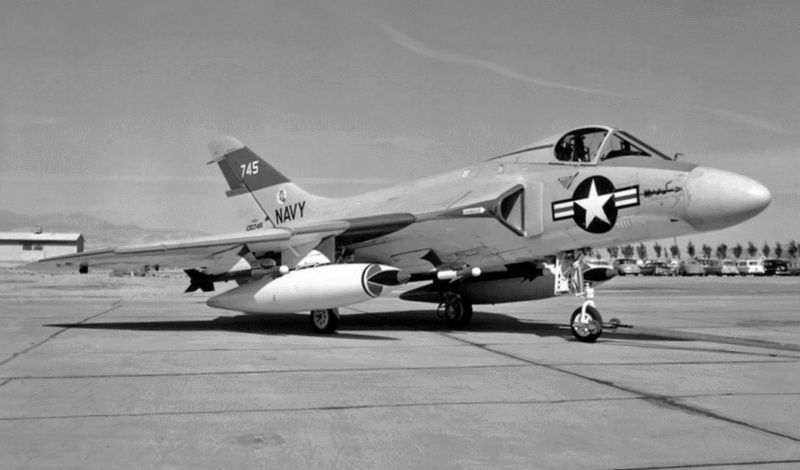
The centerline pylon could be used to carry a "navigation pack (NAVPAC)" pod with radio beacon-tracking and distance-measuring gear for flights to USAF or civilian land bases whose navigation gear was different from that used by the Navy. Fuel tanks were always carried on the midwing pylons; it is unclear if any of the other pylons were "wet" as well. Although the Skyray didn't have inflight refueling capabilities itself, it could carry external tanks fitted with nose probes for hose-and-drogue refueling. Very few photographs show this fit, however, and though it was said to have been approved for service, it doesn't seem to have been widely used. Skyrays could also be fitted with a spool for towing a target sleeve or dart-style tow target.
___________________________________________________________________
DOUGLAS F4D-1 SKYRAY:
___________________________________________________________________
wingspan:
10.21 meters (33 feet 6 inches)
wing area:
51.75 sq_meters (557 sq_feet)
length:
13.79 meters (45 feet 3 inches)
height:
3.96 meters (13 feet)
empty weight:
7,270 kilograms (16,025 pounds)
max loaded weight:
11,340 kilograms (25,000 pounds)
maximum speed:
1,160 KPH (720 MPH / 625 KT)
service ceiling:
16,800 meters (55,000 feet)
range:
1,930 kilometers (1,200 MI / 1,045 NMI)
___________________________________________________________________
In service, the Skyray was generally painted in pleasing light gull gray on top and white on the bottom, with trim paint in other colors, such as red to highlight the potentially dangerous engine inlets to ground crew, and (not as universally) a black radome and anti-glare panel in front of the windscreen; the anti-glare panel was often painted dark gray instead.
Unit-specific colors could be very diverse and often spectacular: one particularly snazzy color scheme featured a black spine and tailfin with yellow stars, plus similar stripes down the sides of the external tanks. The brass sometimes found squadron markings too un-military, and there was a running tug-of-war over the issue. Skyrays that were used as test machines, as well as a few that were used as target tugs late in their service lives, had gaudy paint schemes, such as dayglow orange tailfin, wingtips, and other elements.
BACK_TO_TOP* In service, the F4D-1 was nicknamed the "Ford" due to its "eff-four-dee" designation. Although the delays in development ensured that the Skyray had a short operational history, pilots really admired its capabilities. It had a terrific rate of climb; following some informal climb trials by Bob Rahn in a production Skyray in 1955, Marine Major Edward N. LeFaivre used the Ford to establish a set of world climb records in May 1958. It was also very maneuverable, featuring an incredible rate of roll.
Air Force pilots flew the F4D, no doubt with an eye to assessing its strengths and weaknesses. It did have weaknesses, significant ones, with lists of flight restrictions placarded in the cockpit to make sure pilots didn't forget them. Along with its agility came a degree of instability, particularly in the critical transonic speed range. That doesn't seem too surprising given the aircraft's aspect in the top view, which suggests some of the aerodynamic features of a pancake; it also had a steep glide ratio, being described as a "lead sled".
One pilot said the Ford's handling "bordered on the bizarre." In fact, there were some test pilots who despised the F4D, and felt it should have never been accepted into operational service. That appears to have been a minority opinion, but even the Ford's admirers admitted its instability made it a handful for a relatively inexperienced pilot. Skilled pilots who liked the machine also found it tiring to fly for long distances, since keeping it on the level was a continuous balancing act. Of course, modern digital fly-by-wire flight control systems would have tamed the Skyray, even exploited its instability to optimize maneuverability -- but such technology was all but unimaginable in the Ford's day.
Stability is regarded as a good feature for carrier landings, and getting a Skyray on deck could be tricky, one pilot saying that was where "the Ford really got your attention." The wing was big, resulting in low wing loading, meaning the aircraft tended to be overly responsive to air disturbances. It also tended to "skid out" when the landing gear was lowered, because one main gear would drop before the other. One pilot compared it to "standing on top of a pencil" -- not a particular worry for daylight landings in clear weather, but "not so good" for instrument landing conditions.
The F4D-1 had a high angle of attack (AOA) on its critical carrier approach; however, pilots claimed the forward view was excellent, and the high AOA wasn't such a problem. On the other side of the coin, one pilot who didn't like the thing noted that the tailfin would be masked out by the wing at high AOA, reducing the aircraft's controllability still further, with low speed flight amounting to "a series of wallowing, half-roll, half-sideslip maneuvers that made the bird look drunk." Another Skyray pilot commented on watching one of his colleagues make "seven unsuccessful passes at the deck. We thought we might have to shoot him down, but on the eighth attempt, he landed."

Take-offs could be tricky -- the main gear didn't go up together either, causing the aircraft to skid out again -- though once pilots got used to the Ford, they didn't have a problem with it. However, it was regarded as something of an amusement to watch green pilots try to get it off the deck. In general, it seems that the Ford's eccentricities were not regarded by most pilots as anything all that threatening, and those who enjoyed flying the machine said its idiosyncrasies helped make it fun to fly.
The F4D also had a number of difficulties common to jet fighters of its generation. The cockpit was an ergonomic slum; that wasn't unusual in those days, the term "ergonomics" having hardly been invented, but pilots complained that the stick blocked the view of the radar display, evidence of the fact -- obvious to anyone who's ever worked in a development environment -- that engineers can be clueless at times. To add to the embarrassment, the simple solution to the problem was provided, not by Douglas engineers, but by a Navy ground crewman who was clever with his hands. He lifted two small mirrors from his wife, then fitted them into a cardboard frame to build a periscope so the pilot could actually see the radar screen over the top of the stick. This scheme worked so well that the Navy ordered construction of a formal periscope with a plastic housing, and installed them in Fords in service as standard kit.
The F4D's range left something to be desired -- it was always flown with external tanks -- and the reliability of its subsystems was poor. For example, although pilots praised the radar, it tended to be out to lunch a good part of the time. One pilot observed: "It had a good many things in the cockpit that never worked and indeed could not be maintained ... this was typical of the analog era. Now when you step into an F-18, everything works nearly all the time." In addition, although the landing gear was very solid, the airframe itself was a fairly high-maintenance item.
Most pilots had no confidence in unguided rocket packs for interception. The folding-fin rockets jinked around like crazy until the fins deployed, and the usual comment was: "It was a wonder anybody could hit anything with them." Attacks on target drones apparently bore this out. The Sidewinder AAM was a big step in the right direction, but as Vietnam would prove, the Sidewinder needed some work to be turned into the "wonder weapon" it was promoted as being early on.
* The F4D not only served with the US Navy and Marines, it also served under USAF command, though not with USAF pilots. One Navy Skyray squadron, VFAW-3 out of North Island in San Diego, was assigned to the North American Air Defense (NORAD) system under Air Force control, scrambling to intercept intruders entering the southwestern corner of the USA. The Navy Skyrays participated in Air Force interceptor competitions and walked away with their share of prizes. VFAW-3 Skyrays deployed to Naval Air Station Key West in Florida during the Cuban Missile Crisis in the fall of 1962, protecting US airspace from Cuban intruders. There were radar contacts with MiGs, but nobody ever tried to pick a fight.
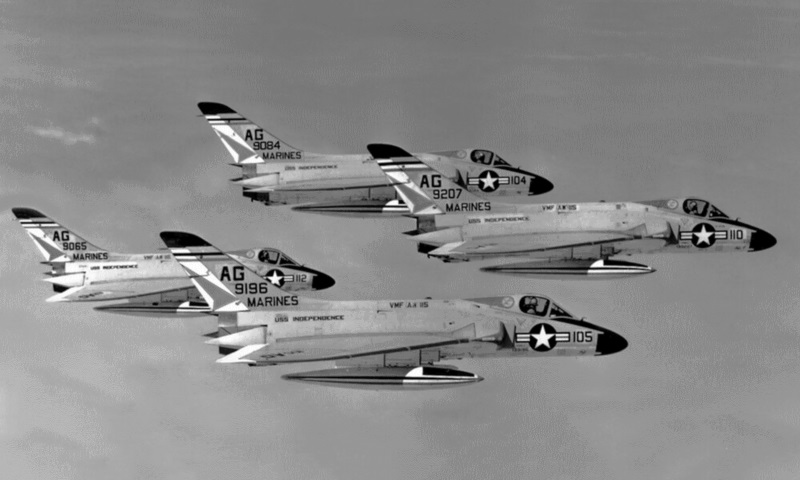
A total of 420 Fords had been built by the time production ended in December 1958. It never saw any real combat service and there were no export users -- though Douglas did demonstrate the type to potential buyers, including the government of India. The type was redesignated "F-6A" when the US military consolidated aircraft designations in September 1962, but by that time, the Skyray was increasingly being shunted off to the reserves. In 1962, a few were fitted out as target drone controllers and redesignated "DF-6A".
The Skyray had been completely phased out by the end of the 1960s. One of its last duty posts was at the Navy Test Pilots School at Patuxent River in Maryland, where it was used to give students familiarity with how an unstable aircraft flew. One cynic also said that the school held on to its Skyrays for so long simply to hammer in the lesson: "Don't ever buy another one like this airplane." However, the Ford appears to be remembered with some affection -- tempered by an awareness of its peculiarities, and the realization that it probably wasn't the best combat aircraft the Navy and Marines ever flew.
The machine at the Navy Test Pilots School still remains on display there at last notice, and several others survive as static displays at museums in the US. No Skyray remains in flightworthy condition.
BACK_TO_TOP* Douglas designed an improved Skyray, originally to be designated the "F4D-2", but later redesignated the "F5D-1 Skylancer". It had the same general configuration as the F4D-1 and could be easily confused with it at a casual glance -- but featured a substantial fuselage stretch, 35% more internal fuel capacity, thinner wings, a taller tailfin, and more engine power to give it true transonic performance.
19 were ordered for evaluation. The initial prototype performed its first flight on 21 April 1956. It was fitted with the same P&W J57-P-8 engine used on later production F4D-1s, but production aircraft were to use the new General Electric GE J79 afterburning turbojet, providing a significant step up in power, as well as better fuel economy. As mentioned, GE actually used the second XF4D-1 prototype as a testbed for the YJ79, with the aircraft performing its initial flight with the YJ79 in December 1955. Fit of the new engine was relatively straightforward, since the J79 was smaller than the J57. The prototype was then fitted with the commercial version of the J79, the CJ805-3, in 1958, with the prototype also carrying a wooden test model of the turbofan derivative, the CJ805-23, on an underwing pylon for aerodynamic tests.

Production Skylancers were to feature armament of four retractable unguided rocket launchers with a total of 72 rockets, or four 20-millimeter cannon, plus two Sparrow II medium-range semi-active radar guidance AAMs. The Sparrow II had been test-evaluated on the F4D-1.
___________________________________________________________________
DOUGLAS F5D SKYLANCER:
___________________________________________________________________
wingspan:
10.21 meters (33 feet 6 inches)
wing area:
51.75 sq_meters (557 sq_feet)
length:
16.40 meters (53 feet 10 inches)
height:
4.51 meters (14 feet 10 inches)
empty weight:
7,912 kilograms (17,444 pounds)
max loaded weight:
13,210 kilograms (29,122 pounds)
maximum speed:
1,534 KPH (953 MPH / 828 KT)
range (clean):
2,148 kilometers (1,335 MI / 1,160 NMI)
___________________________________________________________________
Only four of the 19 evaluation aircraft were actually built, all of them fitted with the J57 engine. Although one was lost in an accident, the Skylancer actually did well during its evaluation -- but the Navy was acquiring the new Vought F8U Crusader in parallel, the Crusader was clearly the better bet, and the Skylancer program was canceled.
NASA obtained two of the surviving Skylancers in 1961, using them in tests for the X-20 Dyna-Soar spaceplane, which was a winged spacecraft that would be launched on a Titan booster. The Skylancers, painted in gaudy red and white colors, were used to simulate mission abort procedures, in which the spaceplane had to escape the Titan booster after a launch failure and then land safely. The test pilots regarded the exercise as great fun; one of them, Neil Armstrong, would be the first man to set foot on the Moon. Dyna-Soar was canceled in 1963, but one of the Skylancers remained in service with NASA for various trials through the decade, finally being retired in 1970.
BACK_TO_TOP* The Skyray was not the only delta-winged jet fighter flown by the US Navy, being complemented by the Convair XF2Y "Sea Dart" -- a delta fighter that could take off and land on water.
After the end of World War II, there was substantial interest from the US military and aviation industry in a jet-powered seaplane fighter, since it would be able to operate from forward areas without need of airfields. Following up studies performed from 1946, in response to a 1948 US Navy requirement, the Convair company came up with a subsonic seaplane fighter design known as the "Skate" -- something along the lines of a swept-wing seaplane version of the Douglas Skyknight night / all-weather fighter, with a side-by-side canopy for pilot and radar operator, twin Westinghouse XJ40 turbojet powerplants with intakes just below and behind the canopy, and four 20-millimeter cannon in the wing roots.
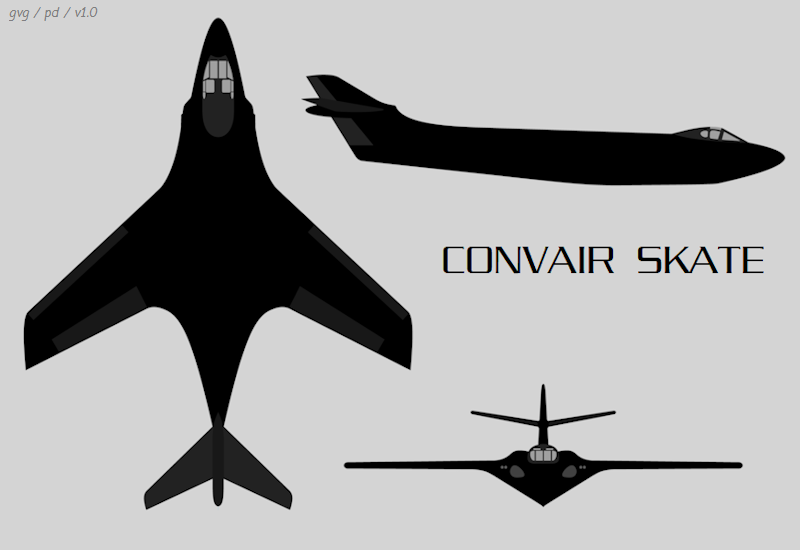
During the same timeframe, the US Air Force was, somewhat surprisingly, also interested in a seaplane fighter, with the Edo Corporation -- a manufacturer of floats for floatplanes -- coming up with a design designated the "EDO 150". It was a single-seater with swept wings, a vee tail, an extendable "hydro-ski" on the belly, wingtip floats, twin Allison J35 turbojet engines fed through an intake on the back, and armament of four 20-millimeter cannon in the wing roots. The hydro-ski allowed a flying boat to dispense with the boat hull, improving aerodynamics and reducing weight.
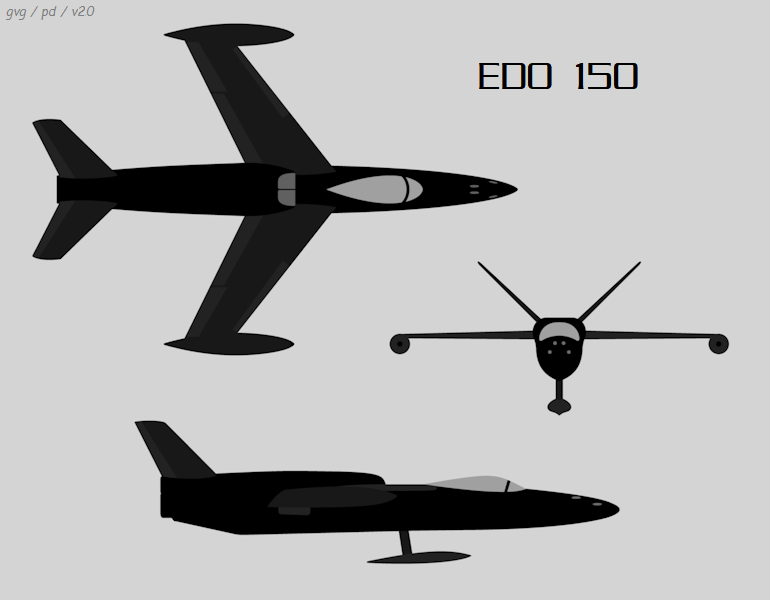
The Edo 150 never advanced beyond the model stage, though a Grumman Goose seaplane was used to trial the hydro-ski concept, which turned out to work very well. The Convair Skate never happened either, since in 1950 the Navy revised the seaplane fighter requirement to specify a supersonic machine. The Navy wasn't certain at the time that a supersonic aircraft could be operated from a carrier of any reasonable size and felt a seaplane fighter might be preferable.
Convair came up with a proposal, which won the competition on 19 January 1951. The contract specified two prototypes of a single-seat delta-wing fighter, to be designated the "XF2Y-1 Sea Dart", that took off and landed on water using two retractable hydro-skis. The engines were mounted on the back of the aircraft, with the intakes well up above the wings to prevent water ingestion during take-off and landing. Incidentally, the Skate program was not discontinued immediately, with Convair continuing studies on variations for a time, building a 1/7th-scale model for hydrodynamic tests.
The Sea Dart had a vee-shaped hull, the aircraft's internal spaces being organized as multiple watertight compartments to keep it afloat if battle damaged. It had twin dive brakes on the lower rear fuselage that could be also be used as water brakes or rudders. Flight controls were hydraulic. The Sea Dart could not take off or land on a runway, but each of the hydro-skis had a small wheel at the end, and a third small wheel was mounted near the rear of the aircraft to allow it to taxi onto or off of a seaplane ramp. The cockpit canopy pivoted up as a single unit, and featured a somewhat antique-looking windscreen with twin oval glass panels in a metal frame. Apparently the pilot field of view was not very good.
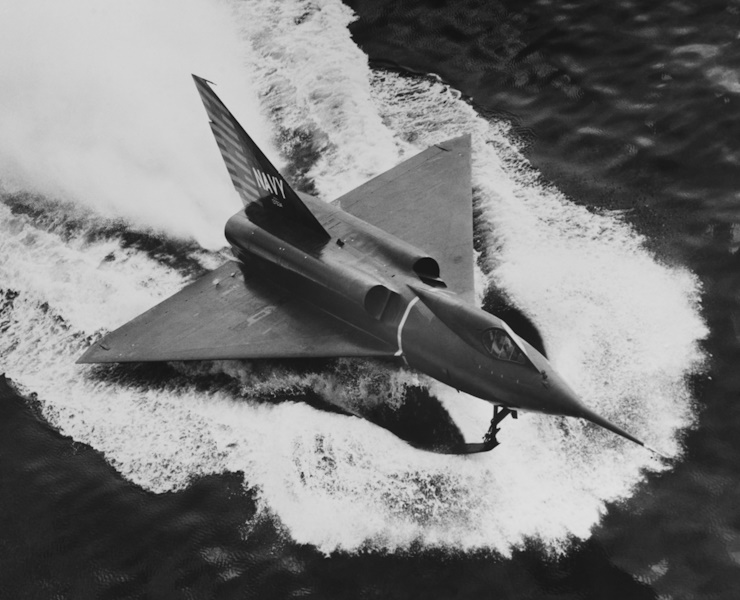
The Sea Dart was originally planned to be powered by twin Westinghouse XJ46-WE-02 engines with 26.68 kN (2,720 kgp / 6,000 lbf) afterburning thrust each. The XJ46 engine, an afterburning derivative of the Westinghouse J34 axial-flow turbojet, was expected to give the aircraft a top speed well in excess of Mach 1. The aircraft was to be fitted with an Aero 13E fire-control system with AN/APS-50 radar, and armed with four 20-millimeter cannon, plus a pack of FFARs -- though in fact, no Sea Dart would ever be armed. Navy brass were so enthusiastic about the Sea Dart that even before it flew, the service ordered a total of four "YF2Y-1" service evaluation aircraft and 16 "F2Y-1" production aircraft.
* Since the first Sea Dart prototype was finished before the XJ46 engines were ready, the aircraft was fitted with twin Westinghouse J34-WE-32 engines providing 15.11 kN (1,540 kgp / 3,400 lbf) maximum take-off thrust each. Taxi trials began in San Diego Bay in mid-December 1952, with test pilot Sam Shannon at the controls, leading to its first official flight on 9 April 1953. The Sea Dart was, to nobody's surprise, badly underpowered with its J34 engines, and remained solidly subsonic. The hydro-skis turned out to give an extremely rough ride on take-off and landing, though a redesign effort helped reduce this problem. It would also turn out, also to no great surprise in hindsight, that the salty sea air was hard on engines.
The XJ46 engines were installed in the prototype later that year, but they failed to meet their designed thrust levels. The detestable Vought F7U Cutlass carrier would use production J46 engines, with the lack of engine power and poor fuel economy high on the list of pilot complaints against the "Gutless", as it was known.
At this point, the Navy began to rethink the Sea Dart program. The second prototype was canceled, with development moving on to the first service evaluation YF2Y-1, fitted with J46 engines, although the Navy was seriously looking for a better powerplant. The YF2Y-1 was similar in appearance to the XF2Y-1 but had a longer, redesigned exhaust, and the little beaching wheels were removed from the hydro-skis and the fuselage, meaning it had to be fitted with external beaching gear to be brought up on shore.
The YF2Y-1 began test flights in 1954, and on 3 August 1954 Convair test pilot Charles E. Richbourg took the machine through Mach 1 in a shallow dive. The Sea Dart is believed to be the only seaplane to ever break Mach 1. However, since it had been designed before the new "area ruling" scheme was introduced, its supersonic handling characteristics were poor. The YF2Y-1 was lost in a crash during a low-level demonstration on 4 November 1954, killing Richbourg in full view of a press tour. The accident essentially killed the program as well. The Navy was no longer particularly fearful of operating supersonic aircraft off carriers, and despite improvements in the hydro-ski design, the Sea Dart still suffered from serious vibration on take-off and landing.
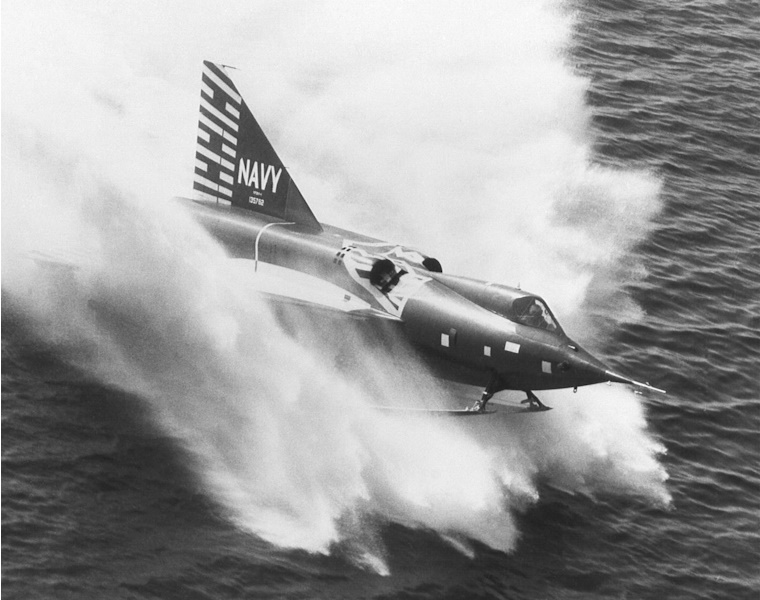
The Navy had begun cutting back the program in December 1953, before the delivery of the YF2Y-1, canceling ten of the production aircraft. The other six were killed off in March 1954, well before the fatal accident. Following the accident, the program was further scaled back to a test exercise, and plans to produce an "F2Y-2" with area ruling and a single Pratt & Whitney J75 turbojet with 66.71 kN (6,800 kgp / 15,000 lbf) thrust were abandoned.
The XF2Y-1 was then refitted with twin J46 turbojets and a single-ski configuration in hopes that would solve the take-off and landing problems. The fit was strictly experimental. The ski was not fully retractable and the wells for the old twin skis were not faired over. The new single ski had a pair of retractable beaching wheels at the end, allowing the aircraft to beach itself. The modified XF2Y-1 first flew in late December 1954; after some initial problems, the single-ski scheme proved remarkably successful, allowing safe take-offs and landings even in fairly rough seas.
___________________________________________________________________
CONVAIR YF2Y-1 SEA DART:
___________________________________________________________________
wingspan:
10.26 meters (33 feet 8 inches)
wing area:
52.30 sq_meters (563 sq_feet)
length:
16 meters (52 feet 7 inches)
height, skis extended:
6.33 meters (20 feet 9 inches)
empty weight:
5,725 kilograms (12,625 pounds)
loaded weight:
9,750 kilograms (21,500 pounds)
max speed at altitude (estimated):
1,325 KPH (825 MPH / 720 KT)
service ceiling (estimated):
16,700 meters (54,800 feet)
range (estimated):
820 kilometers (510 MI / 445 NMI)
___________________________________________________________________
The second YF2Y-1 performed its first flight in March 1955. It was powered by twin J46 turbojets and had a modified twin-ski system, with pivoting beaching wheels at the end of each ski. The twin-ski system didn't work much better than before, and the aircraft was put into storage at the end of April 1955, never to fly again.

The original XF2Y-1 was used for further tests of various ski systems until the fall of 1957, when it was finally withdrawn. Two more YF2Y-1s were built but never flown, and all four surviving aircraft are now in museums. Incidentally, Convair conducted a number of design studies for bomber-sized supersonic flying boats, with configurations ranging from machines that looked somewhat like scaled-up Sea Darts to much larger aircraft; nuclear power was envisioned for some of the designs. Of course, none of them ever came close to happening.
* Incidentally, the Sea Dart was not the only, and not the first, seaplane jet fighter. The British Saunders-Roe ("SARO") firm had actually built three prototypes of a seaplane jet fighter, the "SR.A/1", in the late 1940s.
The idea for a British seaplane jet fighter arose in 1943, when the Allies were considering how to take the offensive against the Japanese in the Pacific. Saunders-Roe officials believed that a seaplane fighter would be useful in this environment, since it would be able to use any atoll or other protected anchorage as a ready-made airfield. Using the new jet engines for such an aircraft had particular advantages, since the lack of a propeller eliminated the need for long, draggy floats, and allowed the fighter to be designed in a more streamlined configuration. Saunders-Roe submitted a proposal for an aircraft along these lines designated "SR.44" to the British Air Ministry, and in May 1944 the Air Ministry blessed the concept by issuing a specification designated "E.6/44" to fit the proposal.
The reality was that the Americans were able to build enough carriers to support intensive forward air operations in the Pacific, and in the absence of any real need, the SR.44 stayed at low priority. Engine development problems contributed to delays, and the first SR.A/1 prototype didn't fly until 16 July 1947. A second prototype took to the air on 30 April 1948, followed by the third, and last, on 17 August 1948.
The SR.A/1 was one of the uglier aircraft ever built, with a classic flying boat hull and jet intakes in the nose, giving it a tubby and "pig-nosed" appearance. It was powered by twin Metropolitan Vickers F2/4 Beryl axial-flow engines, an ancestor of the better-known Armstrong-Siddeley Sapphire turbojet, with the exhausts in the upper fuselage behind the wing.

The first two prototypes were fitted with development versions of the Beryl, but the third prototype was fitted with fully rated engines, with a thrust of 17.1 kN (1,745 kgp / 3,850 lbf) each. The aircraft was fitted with straight wings and tail, featuring wing-mounted stabilizer floats pivoting inward into underwing recesses, and was armed with four Hispano 20-millimeter cannon in the nose above the air intake.
___________________________________________________________________
SANDERS-ROE SR.A/1:
___________________________________________________________________
wingspan:
14.02 meters (46 feet)
wing area:
38.60 sq_meters (415 sq_feet)
length:
15.24 meters (50 feet)
height:
5.11 meters (16 feet 9 inches)
empty weight:
5,108 kilograms (11,262 pounds)
loaded weight:
8,635 kilograms (19,035 pounds)
max speed at altitude:
824 KPH (512 MPH / 445 KT)
endurance:
2.4 hours
___________________________________________________________________
Despite the SR.A/1's uninspiring appearance, its performance was surprisingly good -- but in the postwar period, there was no serious interest in the type. The last of the three prototypes was retired in June 1951.
Saunders-Roe also became interested in the hydro-ski scheme, releasing a proposal for an improved seaplane fighter, the "P.121", in late 1950. The P.121 was a swept-wing fighter, with a Sapphire engine fed by a back-mounted intake, four 20-millimeter cannon, and a single hydro-ski extending from under the front hull. However, the project failed to acquire any momentum, and was canceled in early 1952.
BACK_TO_TOP* In an interesting footnote to the Skyray story, in 1958 an F4D was used to launch a space-launch booster in attempts to orbit a microsatellite resembling a hockey puck with a cone in the middle. The whole scheme, designated Project PILOT, was put together on a shoestring by the Naval Ordnance Test Systems (NOTS) organization. The satellite, which contained a radiation counter and a radio system with batteries for power, was nicknamed "NOTSnik" -- after the Soviet "Sputnik" satellites, which the USSR was using at the time to humiliate the Americans.

The booster was assembled from available solid-fuel rockets and weighed about a tonne. There were six NOTSnik shots in all, conducted in July and August 1958, but the shots were all unsuccessful. The booster was very unreliable, with four launches failing immediately on release, the booster either exploding or falling into the ocean; cobbling together off-the-shelf hardware into a flight system was trickier than it looked. A HAM in Christchurch, New Zealand, reported picking up a signal from one of the NOTSniks, but if so, it wasn't heard from again.
Two years later, in 1960, a Skyray launched two improved derivatives of the NOTSnik booster on test flights under Project CALEB -- there was no attempt to put a payload into orbit this time around. One shot was successful and the program seemed to have potential, but it was canceled, apparently due to political squabbling over space-launch "turf". The exercise didn't really die out then, with a total of three launches in 1961 and 1962 of a larger air-launched sounding rocket named "Hi-Hoe" from a McDonnell Phantom fighter, one launch proving successful. The same booster was also ground-launched in the same timeframe to determine if it could be used as an antisatellite interceptor. That came to little as well.
For whatever reasons, the entire Navy air-launched booster effort remained more or less secret for decades. Some sources claim "NOTSnik" was more or less an acronym for "Naval Ordnance Television Satellite", but though it is now possible to build a hand-sized satellite with a video camera in it -- the "CubeSats" being flown by various universities and startup companies come to mind -- that wasn't remotely possible with the TV cameras available in 1958. Other sources claim it had an infrared sensor, which is more plausible, but it certainly wouldn't have been one capable of providing an image with any detail.
Somewhat more successfully, beginning in 1961, a Skyray was used to launch a series of ten "Sparrowair" sounding rockets, each of which was assembled from two solid-rocket motors obtained from the Sparrow AAM.

* Sources include:
The material on the Sea Dart owes a good deal to a very detailed document written by aviation enthusiast Joe Baugher.
* Illustration credits:
* The material on the Convair Sea Dart was originally published as a separate article in 2003. It was folded into this document in 2023. Revision history:
v1.0.0 / 01 aug 04 v1.0.1 / 01 dec 05 / Review & polish. v1.0.2 / 01 sep 06 / Review & polish. v1.0.3 / 01 feb 07 / Review & polish. v1.0.4 / 01 jan 10 / Review & polish. v1.0.5 / 01 dec 11 / Review & polish. v1.0.6 / 01 nov 13 / Review & polish. v1.0.7 / 01 oct 15 / Review & polish. v1.0.8 / 01 sep 17 / Review & polish. v1.0.9 / 01 aug 19 / Review & polish. v1.1.0 / 01 aug 21 / Illustrations update. v1.1.1 / 01 jul 22 / Review & polish. v2.0.0 / 01 dec 23 / Added Sea Dart.BACK_TO_TOP
